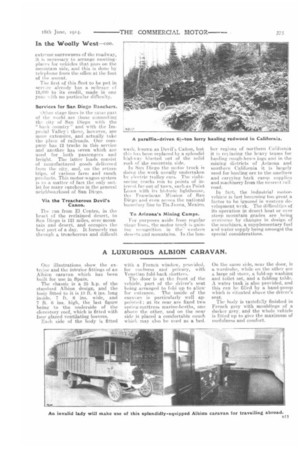Motor Wagons in the Woolly West.
Page 4

Page 5

If you've noticed an error in this article please click here to report it so we can fix it.
Three-ton Wagons on Mountain Roads Routes Along Canons—For Timber Hauling and Mining Camp Transport -Rubbernecking in Mexico.
By a Special Correspondent in Southern California.
The motor wagon is rapidly winning a place for itself in haulage work over the mountain roads of California, Colorado and Arizona, where it is operating in districts that will always be inaccessible to railroads and where hauling by teams is too slow, uncertain and expensive to compete with the motor vehicle.
A good example of this interesting and specialized development is found in the stage lines operated daily in Southern California, to the summit of Mount Wilson, more than a mile high, to Camp Baldy, a resort made popular by the motor stage wagons and to the rich Imperial Valley, from San Diego. These are just three examples out of many that might be cited of stages carrying freight and passengers on regular daily schedules through regions which no railroad serves.
On the Road to the Carnegie Observatory.
The Mount Wilson route lies over a road of extremely bad grades ranging from 12 to 25 per cent, with no level stretch on its 9i miles of length. The road was not designed for general traffic, but was built as a narrow ledge upon the sheer mountain side to accommodate a specially-constructed truck that carried the lens, machinery, etc., to the Carnegie Solar Observatory on the summit. For this reason it was planned as a one-way road, and it served its purpose excellently for the observatory.
Then as the hotel on the summit became more popular, it was found that the road had to be rebuilt in places to allow for general motor traffic, and in the past year it has been used by a regular motor stage line for carrying passengers up to the inn, material for the buildings now being erected about the Observatory, and supplies for the tourists, campers and the colony of scientists which lives on the little plateau on the summit.
Special Wagons For the Various Mountain Roads.
Three commercial motors are used for this purpose at present ; they are one to three-ton Macks, of special design. The constructive changes consist of a shortening of the wheelbase to negotiate the elbow turns and a narrowing of the tread to allow for the narrow roadway. Because of the altitude and also because of the use of low gears on the long climb, a large water tank has been built over the hood B8 of each trpok. Certain carburetter adjustments were also made to allow for the rarity of the atmosphere at various altitudes, and the driver has facilities for the regulation of the carburetter from his seat. Cross-overs Controlled by Telephone.
On account of the sharp turns in the road, the loads of timbers or other long material are placed on the machine projecting in front a: well as behillil. On account of tho extreme narrowness of the roadway, it is necessary to arrange meetingplaces for vehicles that pass on the mountain side, and this is done by telephone from the office at the foot of the ascent.
The first of this fleet to be put in service already has a mileape of 13,000 to its credit, made in one year with no particular difficulty.
Services for San Diego Ranchers.
Other stage lines in the ;.1,:no part of the world are -those cunnecting the city of San Diego with the " back country" and with the Imperial Valley : these, however, are more extensive, and actually take the place, of railroads. One company has 12 trucks in this service and another has seven which are used for both passengers and freight. The latter loads consist. of manufactured goods delivered from the city. and, on the return trips, of various farm and ranch products. This motor-wagon system is as a matter of fact the only outlet for many ranchers in the general neighbourhood of San Diego.
Via the Treacherous Devil's Canon.
The run from El Centro, in the heart of the reclaimed desert, to San Diego is 121 miles, over mountain and desert, and occupies the best part of a day. It formerly ran through a treacherous and diirieult
wash, known as Devil's Canon, but lhs has been replaced by a splendid highway blasted out Of the solid rock of the mountain side.
In San Diego the motor truck is doing the work usually undertaken by electric trolley eats. The sightseeing trucks run to points of interest far out of town, such as Point Loma with its histmic lighthouse, the Franciscan Mission of San Diego anti even across the national boundary line to Tia Juana, Mexico.
To Arizona's Mining Camps.
For purposes aside from regular stage lilies, the motor truck is gaining revognition in the western deserts and mountains. In the turn
bee regions of northern California it is rd. acing the heavy teams for hauling rough-hewn logs and in the mining districts of Arizona and southern California it is largely used for hauling ore to the smelters and carrying back camp supplies and machinery from the lJeiret railroad.
In fact, the industrial inotivvehicle is fast becoming too great a factor to be ignored in western development work. The difficulties of its operation in desert heat or over steep mountain grades are being overcome by changes in design of the machines, a supplementary fuel and water supply being amongst the special considerations.
























